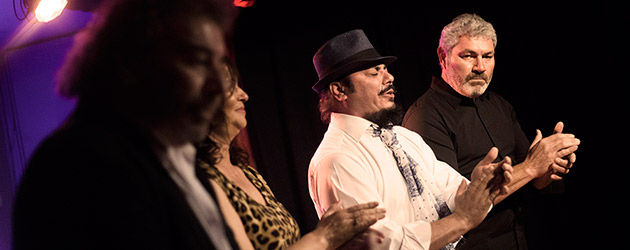Text & photos: Rufo
Miguel El Rubio, Charo De Los Rubio, Antonio «El Ingueta», Luis De Los Rubios, Camarón De Pitita
Café Berlín – June 24th 2016
Los Rubios: hyperbolic creativity
What's the use of having all the technique in the world, if you don't stand out from the rest? That ought to be the basic premise that every artist brings to his work. Be recognizable, have an identity, contribute evolution. If any family with flamenco has a style of its own, it's the Rubios. Their genealogy is deep in the roots of the art itself, and probably Tío Antonio El Rubio and Joaquín el Canastero are the standard-bearers for an absolutely personal way of handling flamenco singing. Their verses and melodies of fandangos, tangos and bulerías have been handed down through generations who have been able to continue adding variation to that which already exists.
This was the show presented by Los Rubios within Madrid's Suma Flamenca, at the excellent venue of one of the capitol's musical temple, the refurbished Café Berlin. Four children of Antonio…Miguel, Charo, Luis and Camarón de Pitita…and one grandson, Antonio Ingueta, were on hand for the occasion, in addition to two family members from another popular Madrid family, guitarist Vaki Losada and percussionist Lucky Losada.
The recital was a flourish of creativity as well as sensitivity. Miguel, Charo, Luis and Antonio opened without musical accompaniment with jaleos, followed by a high-speed version of My Hay to bulerías by Camarón de la Pitita. Luis added the Málaga touch with cantes from that part of the world, followed by tangos and fandangos.
Los Rubios not only contribute music, but also poetry. Their verses are beautiful and very different. Then it was the turn of Antonio Ingueta, the family's young talent, and one of the most interesting flamenco singers in Madrid. Antonio manages to remake the whole family style to pass it through his particular vision. A tireless quest for tonalities that few can manage, but which for him are a piece of cake. Antonio showed there is still much to be discovered in cantes such as tonás and granaína, the latter which he closed out with fandangos in the family line, a sort of delicatessen.
The emotional high point of the evening was probably La Charo. Not even professional, her shyness is obvious, and she had the occasional flaw, but all this is more than forgiven thanks to her communicative power. Her sensitivity is comparable at times to that of her father, Tío Antonio. Her low tones are knives that make the singing a sweet lament. The twang in her delilvery was a delight, as well as her way with soleá and bulerías. The objective of any work of art is to stir emotions. Her singing is a work of art, therefore it is moving. Fantastic.
The night finished with the heir to the family legacy, Tío Miguel el Rubio, another one of the most stylized and sensitive artists in flamenco. You never know where he's going to show up, but the other night at the Berlin, his performance raised gypsy flamenco singing to a high level. Romeras in the style of Chaqueta, with unquestionable quality. The bulería por soleá he sang was worthy of serious study by all those people who talk about the lack of evolution and creativity in cante. Why can't there be «bulería por soleá de los Rubios»? He closed with the family's flagship, fandangos, but to the compás of bulería, leaving no doubt that this family represents a shining asteroid in movement within a static universe.
